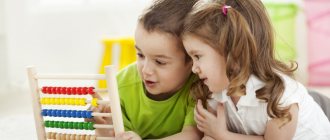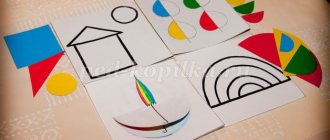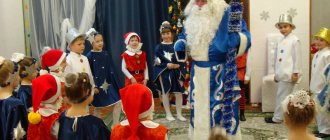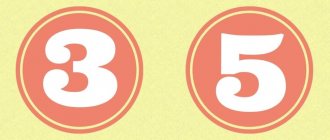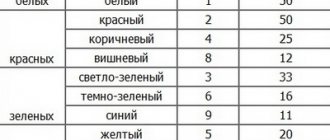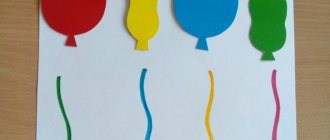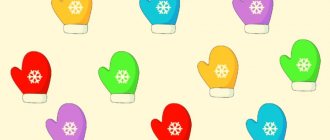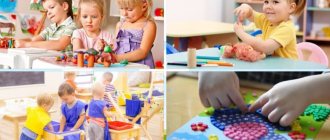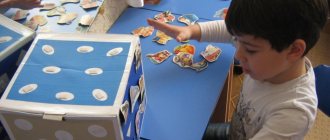Didactic games on FEMP in the younger group
This category presents games for preschoolers aged 3–4 years, teaching grouping, comparison and correlation of objects by size and shape, perception of distance and direction of movement, expanding the understanding of geometric shapes, forming the skill of planar and spatial orientation. Children should develop quantitative concepts and an understanding of the equality of objects.
Regardless of how the FEMP didactic games are divided into groups, it is important to develop fine motor skills and speech skills, and to cultivate perseverance and hard work in children.
Match the item to the figure
Geometric shapes are laid out on one table, small objects on the other. The teacher points to one of the presented geometric shapes. The player’s task is to find an object on another table that is similar in outline to the demonstrated figure. For example, the teacher pointed to a circle, the child takes a round cosmetic mirror from the table.
Geometric Lotto
To play, you need cut out cardboard images of basic geometric shapes, as well as lotto cards depicting these same shapes. The teacher distributes cards to the students and asks them to put the cut out figures on the lotto so that they cover the corresponding geometric images. Laying out the pieces, each player traces them with his finger and names them out loud.
Assistants
The teacher fills buckets with different types of substances: sand, small pebbles, scraps of paper, grain, etc. Asks the students to use a spatula to pour the contents into empty buckets. Children, while completing the task, tell what is more difficult for them to pour, what is easier, what substance weighs more.
Beautiful scarf
To play, you need to cut out images of autumn leaves of different sizes, colors and shapes from colored paper. The teacher hands out handkerchiefs to the children and takes one for himself. Then he suggests that they work together to decorate the scarves. The teacher decorates his scarf, the children repeat the pattern after him, while saying how many leaves of a certain color and shape are laid out in each corner of the scarf, in which direction they are laid, whether the number of leaves is equal or not, how to equalize them.
Next, each child decorates the scarf in his own way, telling which leaves he used and in what quantity.
Two tracks
The teacher lays out two tapes on a horizontal surface: one is noticeably wider than the other. Next he distributes toy cars to the children. The task is to drive along the paths. While completing the task, preschoolers conclude that only one car can drive along a narrow track, but two cars can drive along a wide track at the same time.
Race crawling
Children play in pairs and stand at one end of the playroom. At the other end, the teacher places two objects on the floor. One item should be closer to the children. At the signal, players lie down on their stomachs on the floor and begin to crawl towards their goals. One player gets to the item faster. The teacher asks the other students why this happened. Children must infer that because of the different distances between players and objects.
Treats for bunnies
The teacher places toy bunnies on the table and asks the children to treat them with carrots. As the game progresses, the teacher asks questions to which the players must answer clearly:
- “How many bunnies came to visit us?” - "A lot of";
- “How many carrots?” - "A lot of";
- “Are there more or fewer carrots than bunnies?” - “Equally.”
Paths
The teacher tells the students that the bunny and the badger live in cozy holes, but there are no paths to the house. Next, he shows the children pictures depicting holes at different distances from the animals. The players' task is to draw paths with a pencil to the holes of the bunny and badger, and at the same time say which path is long and which is short.
Similar pictures can be made for other animals.
Didactic games on FEMP in the middle group
We present games for the formation of elementary mathematical concepts in preschoolers 4–5 years old. Children learn to count, operate with spatial and temporal representations, analyze, compose, compare, organize objects, and use appropriate lexical concepts. Preschoolers develop color perception and an understanding of sequence. Games develop memory, speech skills, concentration, and the ability to think logically.
Geometry
Children receive 10–20 counting sticks and 2 laces 20–30 cm long. These devices are used to create various flat figures. The sticks are used to make shapes with angles: squares, rectangles, triangles of different sizes. And the laces are made into ovals and circles.
Beads for matryoshka
The teacher prepares a cord and attaches small images of geometric figures in a certain order to it from the right edge. Next he asks the children to continue making beautiful beads for the nesting doll. Players take geometric figures from the box and stick them on a string in the correct order.
Harvest
To play, you need two different-sized baskets and images of vegetables and fruits of different sizes. The game task is to sort the harvest into baskets: put large fruits in the larger one, and small ones in the smaller one. During the game, children tell what size baskets they see in front of them, what vegetables and fruits they put in them.
Tails
To play you need toy animals: elephant, bunny, monkey, fox, bear cub. Animals cannot figure out whose tail is longer. Children must resolve the dispute. They measure the tails by placing them next to each other and compare them using the appropriate adjectives: long, short, big, small.
Right wrong
The teacher distributes two circles to the students: red and green. Then he pronounces phrases on the theme of the seasons of the year and time of day. Children raise a red circle if the phrase is incorrect, for example, “after autumn came spring.” Or a green circle if the phrase is correct, for example, “the boy does exercises in the morning.”
Find the item
The teacher hides an object in the playroom, and the child must find it, following the clues. The teacher says, for example: “Three steps to the right, one forward, bend over, look under the table.” The child tries to do everything he hears.
Circle and oval
The teacher attaches several ovals and circles of different sizes and colors to the magnetic board. He asks how the figures differ and how they are similar. The children answer that they have no corners. The teacher invites the students to roll the figures on a horizontal surface. Children note that circles roll easily, but ovals do not. They reason about why this is so and superimpose the figures on top of each other. And they come to the conclusion that the ovals are elongated, so they cannot roll.
Tell me the time of day
For the game you need plot pictures of what children do during the day: exercise, breakfast, brushing teeth, walking, etc. The teacher shows the picture, the player names the time of day when the depicted action occurs. For a correct answer he gets a chip. The player with the most chips wins.
For some actions there may be two correct answers. For example, you should brush your teeth in the morning and evening.
Find a place
Children stand in a row. The teacher gives each player a task where to stand. For example: “Misha, stand to the right of Olya”, “Vova, stand behind Kostya”, “Yulia, stand in front of Vitya”. Having distributed themselves in the indicated places, the children say in detail who is in front of them, behind them, to the right and to the left.
Card index of didactic games on FEMP for the preparatory group
Elena Akishina
Card index of didactic games on FEMP for the preparatory group
annotation
The formation of elementary mathematical concepts is carried out under the guidance of a teacher as a result of systematically carried out work in and outside the classroom, aimed at familiarizing children with quantitative, spatial and temporal relationships using a variety of means. Didactic tools are unique tools of the teacher’s work and instruments of children’s cognitive activity. This card file is intended for teachers of the preparatory group of kindergarten . The card index contains various games for developing attention, imagination, logical thinking, etc.
"Funny account"
Goal: development of attention, counting skills, consolidation of knowledge of figures and numbers.
Equipment: for the game you will need two tables, with 20. In each circle a number from 1 to 20 is written in random order.
Content. Two players take part in the game. When given a signal, they begin to count from 1 to 20, pointing to the corresponding numbers. The winner is the one who completes the task faster and without errors.
"Seasons"
Goal: consolidate knowledge about the time of year.
Equipment: Envelopes with puzzles depicting the seasons.
Content. Envelopes are unfolded. The players choose any envelope and collect a picture . They turned into 4 "seasons"
. Everyone remembers what they can tell about themselves.
"Guessing Game"
Purpose: to train children in counting.
Equipment: yogurt boxes or plastic cups. Write or stick numbers on each cup. Choose a toy that will fit in the cup.
Content. This game is played by two people. Place the cups upside down. One player turns away, while the second player hides the toy in one of the cups. The first player must guess under which cup the toy is hidden, and the second must give him hints. For example: the toy is hidden under a cup with the number 5. The player asks: “Under the second?” - "No more".
"Find the figure"
Purpose: to practice comparing the shapes of objects depicted in paintings with geometric figures.
Equipment: models of geometric shapes, pictures of objects consisting of several parts, riddles about geometric shapes
Contents. Assignment: “I will make riddles about figures, and you, among your pictures, choose those on which objects of the same shape are drawn. If you have an object that has a part of the same shape, you show that card too .”
"Make it out of sticks"
Goal: practice making geometric shapes from sticks.
Equipment: counting sticks for each child.
Content. The child, according to the model, lays out any image or figure from the counting folders.
“Who can pick up the boxes faster?”
Goal: learn to compare objects by length, width, height.
Equipment: 6-8 boxes of different sizes.
Content. Having found out how the boxes differ from each other, the teacher explains the task: “The boxes are arranged mixed: long, short, wide, narrow, high and low0 Now we will learn how to select boxes of the right size. Let's play “Who can pick the boxes by size the fastest? Calls the children, gives them one box each. Then gives the command: “Boxes of equal length, stand in place!”
(or width, height)
.
The first pair of children is asked to select boxes that are equal in height and place them so that it can be seen that they are the same height. You can suggest building the boxes in a row (for example, from highest to lowest)
.
"Take Your Place"
Goal: to practice ordinal counting and tactile counting.
Equipment: two sets of cardboard cards with buttons from 2 to 10 sewn on them in a row.
Content. The players stand in a row, hands behind their backs, with 10 chairs in front of them. V. distributes cards . Children count the buttons and remember their number. At the signal: “Get the numbers in order.”
, each of the players stands behind a chair, the serial number of which corresponds to the number of buttons on his
card .
"Tell me what you see"
Goal: to teach to master spatial concepts.
Content. Each child has a picture . The players must tell how the elements of the pattern are located: in the upper right corner there is a cloud, in the upper left corner there is a sun, in the lower left corner there is a house, in the lower right corner there is a tree, in the middle there are birds, and so on.
"Stars"
Goal: practice counting forward and backward within 10.
Equipment: cards with stars drawn on them from 1 to 10.
Content. Children choose cards . The driver is selected. Children run around the room. At the driver’s signal: “Numbers!” Get in order!"
- they line up and name their number.” The driver checks to see if everyone is in place.
Then the children exchange cards .
Game continues. “Where are the figures?”
Goal: learn to classify shapes according to 2 properties.
Equipment: set of figures.
Content. They play in twos. Each has a set of figures. They make moves one by one. Each move consists of placing one piece in the corresponding cell of the table.
"How the figures are arranged"
Goal: to teach children to place geometric shapes on a plane.
Equipment: 2 tables on which 1 figure is drawn in the middle and around it (top, bottom, right, left, one figure each, a sheet of paper, an envelope with models of geometric shapes (circle, square, rectangle, triangle, oval)
.
Contents: The teacher hangs up a table with geometric figures and explains the task: “Look at the table carefully, remember how the figures are located and place your figures on the sheet in the same way. To remember everything well, you need to look at the table in the following order: first name the figure located in the middle, then at the top and bottom, right and left. Who wants to tell you how those figures are placed? After this, V. turns the table back to the children. Having completed the task, the children tell how they placed the figures, compare the results of their work with the sample, and correct mistakes. Similar tasks may be given.
"When it happens"
Goal: to consolidate knowledge about the parts of the day.
Equipment: model of the day, pictures .
Content. V. sets up a model of the day, the arrow points alternately to different parts of the day - children choose those pictures that depict the work activities of people carried out at this time of day. Sample questions: What is shown in the picture ? Why did you choose this particular picture ? What is this part of the day called?
"Who is first"
Goal: development of attention.
Content. The teacher hangs up a picture in which objects are depicted in a row from left to right or from top to bottom. Be sure to agree on where to start counting items: left, right, top, bottom. Claps his hands several times. Children must count the number of claps and find the object that is in the indicated place. Whoever names the item first becomes the driver.
"Flowerbed"
Goal: to consolidate the concept that the number of objects does not depend on the distance between them.
Equipment: typesetting canvas with 2 stripes, object pictures with images of flowers (7 pieces each, cards with 2 free stripes.
Content. On the typesetting canvas there are 2 rows exactly one below the other, each with 6 drawings of poppies and asters. V. says: “Imagine that this is a flowerbed and flowers grow on it in two rows. How many poppies? Let's count everything together! Can you tell how many asters are there without counting them? Why can this be said? Let's check. Kolya, count the asters out loud! Now I will replant poppies and asters. V. places poppies close to each other and increases the distance between asters. What changed? How do poppies grow now? Asters? Are there equal numbers of flowers now? How can you prove that there are equal numbers of flowers? (Adds 1 poppy)
.
How many poppies are there? How did we get 7 poppies? What flowers are there now (fewer? How to prove that there are more poppies? Which number is greater? (less: 6 or 7?)
How to make it clear that there are more poppies than asters?
"Journey"
Goal: to teach how to navigate in space.
Content. The teacher marks the direction on the floor of the group room with an arrow ; different colors, and says to the child: “First go where the red arrow points, then turn where the blue arrow points, then walk three steps and look there.” The tasks can be any for one child or for the whole group of children .
“So many different toys”
Goal: to consolidate knowledge about the basic rule of counting: you can count in any direction without missing a single item.
Equipment: sets of toys, number figures with the number of circles from 6 to 10 (3-4 cards for each number )
;
cards on which different objects are drawn in quantities from 5 to 10 (3-4 cards for each number , (and the objects are arranged differently: in a circle, in two rows, vertically or horizontally) 1-2 cards for each child :
The teacher places three groups of objects in a row on the table and asks: “How do you know how many different toys there are?”
One child is asked to count some toys from left to right, and the other child is asked to count the same toys from right to left. In conclusion, he asks: How did the children count the toys?
Has the counting result changed? And he concludes: “When you need to find out how many objects, they can be counted in any direction, the result will be the same.” V. places 3 numerical figures on the board, and cards with pictures of objects on the table with the pictures down. Then he turns to the children: “The cards are on the table with the pictures down . Those whom I call must take one card each, count how many objects are drawn on it, find a card with the same number of circles drawn on it, and put their own under it.
The one who does it correctly and faster than others will win.” "Find a paired picture "
Purpose: orientation on the sheet plane; learn to describe the location of geometric shapes on cards .
Content. 7-8 cards , paired cards are laid out on the table with the pictures facing down. Assignment: “Now we will play the game “Find a paired picture .” The one I call will take one of the cards on this table and name what figures are on it drawn and where they are located. Then he will find the same card among those hanging on the board and place his own under it.”
"Game with flags"
Purpose: to introduce the composition of the number 10 from two smaller units.
Equipment: 10 flags of different sizes and colors, a set of subject pictures of different types of birds and flowers (12 pieces each)
.
Content. “How many flags are there in total? a group of 10 flags composed ? Since the checkboxes are each color? Which is the last flag?” Then he calls 2 children, asks one of them to select and put in a row 10 pictures of different types of birds , and 10 different types of flowers to the other on the right. pictures they have of different bird objects (flowers and how many there are in total)
.
“Are there equal numbers of pictures of birds and types of flowers ?
How many are there?” "With the Malvinas"
Purpose: to give children the idea that when any number is increased by 1, the next number in order is obtained.
Equipment: set of 5 Malvinas.
Contents: The teacher puts Malvina on the table and asks: “How many Malvinas did I put? How many Malvins will there be if I add 1 more? How did you get 2 Malvinas? If you add 1 more Malvina, how many will there be and why?” (The number of Malvinas is increased to 5)
. The teacher makes sure that the children explain how the next number came about. To what number of items, how many were added, and how many became there? How did you get 5 Malvinas? How did we get a new, next in order number? The teacher clarifies the children’s answers: “That’s right, always when we added 1 Malvina, we got more Malvinas, and we got a new, next in order number. Let's check again."
"Houses"
Purpose: to teach children to use a measure to determine height.
Equipment: 5 sets: each set contains 5 houses with a height of 5, 10, 15, 20, 25 cm.
Content. I will give you the measurements, and you will select the houses of the required height. Whoever finds such a house will come up to me and show me how he measured his house. You need to measure by placing the measure next to the house so that the bottom and top of them match, if they match, then you have found the right house (shows the method of measurement)
"Let's split it in half"
Goal: to teach children to divide a whole into 2 or 4 parts by folding an object in half.
Equipment: strip and circle of paper; Each child has 2 paper rectangles and 1 card .
Contents. Educator: “Listen and watch carefully. I have a strip of paper, I will fold it in half, exactly align the ends, iron the fold line. How many parts did I divide the strip into? That's right, I folded the strip in half and divided it into 2 equal parts. Today we will divide objects into equal parts. Are the parts equal? Here is one half, here is the other. How many halves did I show? How many halves are there in total? What is called half? The teacher clarifies: “Half is one of 2 equal parts. Both equal parts are called halves. This is half and this is half of a whole strip. How many such parts are there in the whole strip? How did I get 2 equal parts? Which is bigger: a whole strip or half? etc.".
Similarly: with a circle.
Next, children learn to independently divide the rectangle in half.
“Who is more and who is less?”
Goal: consolidate counting and ordinal numbers; develop ideas: “high”
,
“short”
,
“fat”
,
“thin”
,
“the fattest”
;
“the thinnest”
,
“on the left”
,
“on the right”
,
“to the left”
,
“to the right”
,
“between”
. Teach your child to reason.
Content. The game is divided into two parts. First, children must find out the girls' names and then answer questions.
"What are the girls' names?"
In the same city there lived inseparable friends: Anya, Olya, Masha, Zina, Katya and Valya.
Look carefully at the picture , take a stick (pointer)
and show who, what is their name, if: Valya is the tallest, Masha, Zina and Katya are the same height, but Katya is the fattest of them, and Zina is the thinnest;
Anya is the shortest. You yourself can find out whose name is Olya. Now show the girls in order: Anya, Olya, Masha, Katya, Zina, Valya. And now show the girls in the same order: Valya, Katya, Masha, Zina, Olya, Anya. How many girls are there in total? Next, the guys answer the questions “Who is standing where?”
“Numbers, stand in order.”
Goal: practice comparing adjacent numbers within 10.
Contents: The teacher calls all the children and gives them a number figure and says: “Now you are not children, but numbers. Numbers, get in order! Are the numbers constructed correctly? Now they will tell us which one and how much more or less than which? Number 1 says to number 2: “I am 1 less than you.”
.
What will number 2 answer him? (Number 2 replies: “I am 1 more than you”
). What do you say to number 3? etc.
"Fill the rectangle"
Goal: Arranging objects according to various criteria.
Equipment: a set of geometric shapes, different in color and shape.
Content. The first player places any geometric shapes, for example a red square, a green circle, a yellow square, in the rectangles not marked with numbers. The second player must fill the remaining cells of the rectangle so that in adjacent cells horizontally (right and left)
and vertically
(bottom and top)
there were figures that differed in both color and shape.
The original shapes can be changed. Players can also change places (roles)
.
The winner is the one who makes fewer mistakes when filling out the spaces (cells)
of the rectangle.
Didactic games on FEMP in the senior group
For older preschoolers, learning to count, add, and subtract is important. Games teach children 5–6 years old to answer questions using numerals.
Name the adjacent numbers
The players stand in a circle, the teacher stands in its center. He throws the ball to the children one by one and names the number. And the players must name the numbers adjacent to the right and left in the row.
Square mosaic
The player receives 36 diagonally cut squares of 8x8 cm. The shapes must differ in color. Each piece of squares must be numbered on the back.
Players complete the following tasks:
- arrange parts of squares by color;
- sorted by numbers;
- put the pieces together into squares;
- combine the parts to form new squares.
Count the balls
The teacher puts balls into large mesh bags: one contains 6 large ones, the other contains 7 small ones. Children guess which bag has more balls. The teacher asks how to prove this statement. At the teacher’s prompting, the children arrange the balls in pairs: small and large. One small ball ends up without a pair. This means there are more small ones. Then the teacher asks how to equalize the balls. You need to either remove one small one or add a large one.
Sound score
Children receive cards with numbers up to 10. The teacher hides behind a fence and knocks on a tambourine or drum a certain number of times. Players listen carefully to the number of strokes, then raise the corresponding number.
The game can be made more difficult. The teacher asks to raise the number, more or less than the number of beats.
Name the day of the week
The players form a circle, the teacher stands in its center. He throws the ball to the children one by one and asks questions about the days of the week. For example: “What day is it before Friday?” or “What day is tomorrow?”
Matryoshka dolls
Players of 6–10 people stand in a row, tie scarves of different colors, and say out loud their serial number. The driver listens carefully, then leaves the room. Two players change places. The driver, returning to the room, speaks using numerals, what has changed. For example: “The yellow nesting doll was sixth, but became third. The blue nesting doll was third, now it’s sixth.” Then the players choose a new driver.
Garages
Players receive cardboard car steering wheels with numbers up to 10 written on them. The steering wheels are painted red, yellow, and blue. The teacher places three chairs with corresponding color marks in different parts of the playroom. At the signal, the children scatter in different directions and run around the room. At the command “To the garage!” everyone runs to chairs similar to the color of the steering wheel. Having reached the garage, they line up according to the numbers indicated on the steering wheels.
Rainbow
The teacher shows the children a picture of a rainbow, lists the stripes, and explains that they are located in a certain sequence. Pupils carefully look at the rainbow, try to remember the alternation of stripes, then close their eyes. The teacher removes the strip or swaps the stripes. Opening their eyes, players try to determine what has changed.
Add and subtract
Children stand in a row. The presenter throws the ball to the children one by one and names a mathematical example for addition or subtraction. And the player who caught the ball must calculate the answer in his head.
Didactic games on FEMP in the preparatory group
For preschoolers 6–7 years old preparing for school, educational games are presented that reinforce basic mathematical concepts.
A week
To play, you need cards depicting numbers from 1 to 7. The players sort them out. Children dance to musical accompaniment. At a signal, they line up in accordance with the numbers on the cards. They call themselves in order: the first player - “I am Monday!”, the second - “I am Tuesday!” and so on.
A similar game can be played with cards from 1 to 12, in this case the players will depict the months of the year.
We are artists
The teacher asks the children to draw a plot picture on a certain topic. For example: street, park, zoo, circus, children's room. During the drawing process, children tell in detail where each element of the drawing is depicted, while using the words: in front, behind, next to, near, right, left, above, below, between, under, above and others.
Compare and continue
The teacher distributes cards to the students depicting geometric figures in cells in a certain sequence. The last cells are empty. The players' task is to determine the sequence of alternating figures and fill in the remaining cells.
Coins
To play the game, you need coins of different denominations as visual material. The teacher sets mathematical examples, and the children solve them. Examples should be of this type: “Vanya had 5 rubles. He bought a bun at the store for 2 rubles. How much money does he have left?
Who should I throw the ball to?
Children stand in several rows. The first player receives the ball. The presenter gives him a task, for example: “Throw the ball to the person standing to your right.” The player who catches the ball receives the following task, for example: “Throw the ball to the person standing in front of you.” And then on the same principle.
Let's fix the car
The game requires an image of a car made up of different geometric shapes. Players look carefully at the image, then close their eyes. The teacher removes 1-2 parts of the machine. Opening their eyes, children try to remember which figures have disappeared.
A set of didactic games in mathematics for the preparatory group
Municipal autonomous preschool educational institution of the city of Nizhnevartovsk kindergarten No. 23 “Geese-swans”
A set of didactic games in mathematics
in the preparatory group
Developed by: Tarverdieva Kunel Vahid kyzy
1. “Name the missing word”
Purpose:
to consolidate knowledge about the days of the week.
Material
.
Ball. Rules of the game:
The host starts immediately and throws the ball to one of the players: - The sun is shining during the day, and the moon is shining. . . — In the morning I came to de, then today. . . - If there was Tuesday after Monday, then after Thursday. . . Similarly, you can play a game about the seasons and months.
2. “Seasons”
Purpose:
To consolidate ideas about the seasons and months of autumn
Materials:
model of the season.
Rules of the game:
The teacher shows the children the “Seasons” model: a square divided into 4 parts (seasons), colored red, green, blue and yellow. The yellow sector is divided into 3 more parts, colored light yellow, yellow and yellow-brown. The teacher asks the children: “How many seasons are there in total? Name them in order. (Shows the seasons on the model, specifying the color.) Show the model autumn. How many parts is this season divided into? Why do you think there are 3 parts? What months of autumn do you know? The last month of autumn is November. Name the months of autumn in order." (September, October, November.) The teacher shows the months on the model.
3. “Stand in your place”
Purpose:
to practice ordinal counting, counting by touch.
Material.
Two sets of cardboard cards with buttons from 2 to 10 sewn on them in a row.
Rules of the game:
The players stand in a row, hands behind their backs, 10 chairs in front of them. V. distributes cards to everyone. Children count the buttons and remember their number. At the signal: “Numbers, stand in order,” each player stands behind a chair, the serial number of which corresponds to the number of buttons on his card
4.
“
Name the day” Purpose
: To consolidate ideas about the parts of the day (morning, afternoon, evening, night)
Materials:
cards depicting the parts of the day.
Rules of the game:
The teacher, together with the children, finds out how many parts a day consists of, offers to name them, show the corresponding pictures and lay them out in the correct sequence (Morning, afternoon, evening, night). An adult offers to make up a day and names one of the parts of the day. Children list the remaining parts of the day and show the corresponding pictures. The game is repeated 2-3 times.
5. “Matryoshka”
Purpose:
to practice ordinal counting;
develop attention and memory. Material.
Colored scarves from 5 to 10.
Rules of the game:
The driver is selected. Children tie scarves and stand in a row - these are nesting dolls. They are counted out loud in order: first, second, third, etc. Does the driver remember where all the nesting dolls and the exit are? out the door. At this time, two nesting dolls change places. The driver enters and says what has changed, for example: “The red nesting doll was the fifth, but became the second, and the second became the fifth.” Sometimes the nesting dolls remain in place.
6. “Find a paired picture”
Purpose:
orientation on the plane of the sheet;
learn to describe the location of geometric shapes on cards. Rules of the game:
4-6 cards are hung on the board, paired cards are laid out on the table with the pictures down. V. explains the task: “Now we will play the game “Find a paired picture.” The one I call will take one of the cards on this table, name what figures are drawn on it and where they are located. Then he will find the same card among those hanging on the board and place his own under it.” V. can call the children one by one, without waiting until the required card is found.
7. “Game with three hoops”
Purpose
: to consolidate the ability to classify objects according to 2-4 properties.
Rules of the game:
The teacher offers a new situation in the game with three hoops. The rule of the game is established, for example, arrange the pieces so that all the red ones are inside the red hoop. Inside the green there are all triangles, inside the black they are all big. The game with three hoops can be repeated many times, changing the rules of the game.
8. “Assemble correctly”
Purpose:
to practice mentally combining objects into groups, in the formation of sets.
Rules of the game:
The teacher points to a table with images of different vegetables and fruits and asks questions: “What is drawn here? What shape are vegetables? (Fruits). What color are vegetables (fruits)? How can you group these items? How many groups will there be then? etc.2.
9. “Guess which number is missing”
Goal:
determine the place of the number in the natural series, name the missing number.
Material.
Flannelograph, 10 cards with images of circles from 1 to 10 on them (on each card there are circles of other colors) flags.
Rules of the game:
The teacher arranges cards on the flannelgraph in the sequence of the natural series. Invites the children to look at how they stand, to see if any numbers are missing. Then the guys close their eyes, and V. removes one card. After the children guess which number is missing, he shows the hidden card and puts it in its place. The first person to name the missing number gets a flag.
10. “Which is wider, which is narrower”
Purpose
: to practice comparing objects by length and width.
Material
.
7 strips of different lengths and widths. Rules of the game:
The teacher invites the children to take stripes, put them in front of them and asks questions: “How many stripes are there in total? What can you say about their size? Show the longest (short, narrow, wide) strip. How to arrange the strips in order from shortest to longest? (Each time you need to take the shortest of the remaining ones). Place the strips in order from longest. In what order did you put the strips? Which is the longest strip? (short?). Where did the narrow strip end up? (wide?). Arrange the strips in order from narrowest to widest. Which is the narrow (wide) strip? Which is the longest (shortest) strip?
11. “Place in order”
Purpose:
to practice comparing objects by length and width.
Material.
Sets of sticks (twigs) of different lengths and thicknesses.
(5 sticks for each child). Rules of the game:
The teacher invites the children to lay out the sticks in front of them and asks: “How many sticks? What is the difference? Because the sticks are different sizes? How will you choose the right sticks in order to arrange them from the thickest to the thinnest? Remember that you need to immediately take the desired stick, you cannot try it on and apply it! After the task is completed, one of the children names the compared thickness of the sticks in the order of their location (thickest, thickest), indicates how many there are in total and which is the longest (shortest). Then the children arrange the sticks in a row in order from longest to shortest and determine where the thinnest and thickest are now.
12. “12 months”
Purpose:
to consolidate the concept of months.
Material:
cards depicting objects from 1 to 1
Contents.
V. lays out the cards face down and shuffles them. The players choose any card and line up in order according to the number indicated on the card. They turned into “12 months.” Each “month” remembers what it can tell about itself. The presenter asks questions: “Fifth month, what is your name?” Is that the name of the second month? Then the tasks become more complicated: “January, come up with a riddle about your month. October remember the proverb about your time of year. March, what year are you in? September, name a fairy tale where your season meets. April, in which fairy tales does your season appear? Further, the game can be complicated. For this, a set of pictures depicting the seasons and pronounced seasonal phenomena is used. Players look at the pictures and choose those that correspond to their month or season
